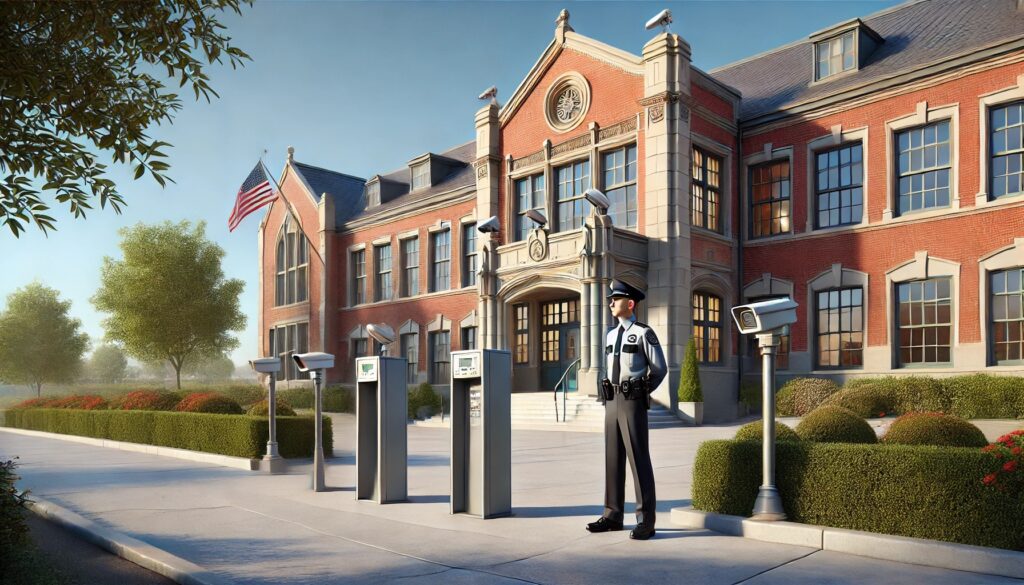
School security is a critical topic that impacts students, teachers, staff, and parents alike. A safe school environment not only ensures the physical protection of those on campus but also fosters an atmosphere conducive to learning and growth. As schools face increasing safety concerns, it’s vital to adopt robust security measures that comply with state and federal regulations. This blog explores key strategies for enhancing school security, important takeaways for school administrators, and the legal framework shaping school safety.
The Importance of School Security
Modern schools must balance being welcoming and accessible while maintaining high levels of security. Safety concerns can range from theft and vandalism to more serious threats such as active shooter incidents. According to the U.S. Department of Education’s Guide for Developing High-Quality School Emergency Operations Plans, comprehensive school security measures are necessary to protect students and staff and to ensure continuity of education during emergencies.
In recent years, public and private schools alike have increased investments in security systems, personnel, and training programs. These measures not only mitigate potential risks but also improve community confidence in the school’s ability to provide a secure environment.
Federal and State Standards for School Security
When designing and implementing school security protocols, schools must comply with various state and federal guidelines, including:
1. The Gun-Free Schools Act (GFSA): This federal law requires all schools receiving federal funding to adopt policies that prohibit firearms on campus, with specific exceptions for law enforcement.
2. The Every Student Succeeds Act (ESSA): This legislation emphasizes the importance of safe and supportive school environments as part of comprehensive education plans.
3. State-Level School Safety Plans: Most states mandate schools to develop emergency operation plans (EOPs) that include procedures for natural disasters, active shooter scenarios, and other emergencies. For example, California’s Education Code Section 32280-32289 requires public schools to develop comprehensive safety plans tailored to local needs.
4. Federal Commission on School Safety Recommendations: After the tragic 2018 Parkland shooting, the Federal Commission released a report recommending advanced security measures such as controlled access points, visitor management systems, and mental health support.
Understanding and integrating these standards into school policies is crucial for compliance and the overall effectiveness of security measures.
Best Practices for School Security
1. Professional Security Personnel
Hiring trained security personnel is one of the most visible and effective ways to enhance school safety. Guards stationed at entrances not only deter unauthorized access but also serve as first responders in emergencies.
2. Surveillance Systems
Installing security cameras at key locations, such as entry points, hallways, and parking lots, can help monitor activity in real time and provide valuable evidence if an incident occurs. Modern systems with AI capabilities can even detect unusual behavior and alert authorities automatically.
3. Access Control Measures
Controlled access points, such as locked doors with keycards, biometric scanners, or visitor check-in systems, ensure that only authorized individuals can enter the premises. These measures significantly reduce the risk of unauthorized access.
4. Emergency Preparedness Training
Regular drills for students and staff help ensure everyone knows what to do in case of emergencies. Training should include evacuation procedures, lockdown protocols, and active shooter response strategies.
5. Community Involvement and Mental Health Support
Building a culture of safety involves more than physical measures. Schools should work with parents, local law enforcement, and mental health professionals to create a supportive environment that addresses potential threats before they escalate.
Additional Takeaways for School Administrators
1. Layered Security is Essential
A comprehensive approach to school security involves multiple layers of protection, from perimeter fencing and lighting to advanced technology and human oversight. Relying on a single solution is insufficient; a combination of measures ensures maximum safety.
2. Stay Current with Regulations
School administrators must remain updated on changing state and federal safety requirements. Partnering with legal experts or consultants can help ensure compliance and avoid costly oversights.
3. Invest in Technology
Modern security technologies, such as facial recognition software, panic alert systems, and cloud-based surveillance, offer cutting-edge solutions for schools. While these investments can be costly, they provide long-term value and enhanced safety.
4. Involve the Community in Security Planning
Engaging with parents, teachers, and students during the development of security protocols ensures a more inclusive and effective approach. Open communication can also alleviate fears and build trust.
5. Evaluate and Update Regularly
Security is an evolving field. Regular audits and updates to security plans are essential to address new challenges and incorporate the latest innovations